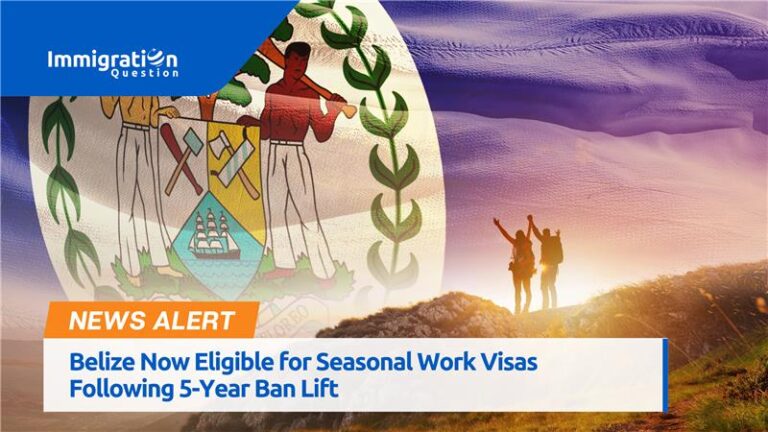Introduction
The Heritage Foundation’s 2025 Presidential Transition Project, known as Project 2025, outlines conservative changes to government policies, including U.S. immigration policy.
Project 2025 is a bold strategy aimed at a potential second term for Trump. It shapes the conservative agenda and focuses on immigrants and those resembling them.
Though Trump has distanced himself from Project 2025, many contributors are his former team members. Many believe it mirrors Trump’s guide for governing if he wins the next election. This news alert provides a quick overview of the main immigration changes proposed in Project 2025.
What is Project 2025?
People curious about life under a future Trump administration can find clues in Project 2025. This plan outlines the GOP’s strategy if Trump wins the November election.
Project 2025 came out in late 2023 from The Heritage Foundation, a right-leaning think tank, and it is like a guidebook for what a second Trump administration might do. Immigration groups are worried it is going to really mess up the country’s immigration system.
Different professionals opine that Project 2025 effects on immigration would be way more complicated and damaging than we thought. It is a carefully planned, all-encompassing strategy to bring immigration to record lows and give the federal government more power over states, which isn’t good. These ideas go around Congress and the courts on purpose to tear down the core of our immigration system.
The proposed immigration policy changes in Project 2025
1. Putting thousands of families apart:
Project 2025, furthermore, aims to make it easier to separate families by stripping away key benefits for unaccompanied minors. Consequently, this plan shifts the responsibility for these children from Health and Human Services to the Department of Homeland Security. As a result, this move would allow the detention of many young children. Additionally, the plan suggests lowering the standards for detaining migrants. For instance, it proposes using temporary facilities, such as tents, to hold them. Consequently, this would make the process of detaining migrants more flexible and less regulated.
2. Problems for foreign students:
Project 2025 suggests increasing oversight for F and J visa recipients to enhance security. The plan directs Immigration and Customs Enforcement (ICE) to play a larger role in the Student and Exchange Visitor Program (SEVP). It also proposes reducing or stopping student visas from countries considered enemies, without specifying which countries or the risks involved.
Foreign students will face financial challenges as the plan restricts in-state tuition to citizens and green card holders. DACA recipients and “documented dreamers,” children of work visa holders, will be excluded. Additionally, birthright citizenship may encounter new and unforeseen issues due to this plan.
3. The H1-B status policy changes:
The visa plan under Project 2025 says that only the top-notch and smartest people should get H1-B visas, and it tells the USCIS to only let certain types of people work in the US. It also sets new salary rules for the Department of Labor (DOL).
Right now, there are four salary levels based on how skilled, knowledgeable, and experienced you are. The Project 2025 rules would remove the lower Level I and II salary levels, which means a lot of jobs for new grads, including those with advanced degrees, would disappear.
This would really mess things up for grad students looking for jobs in the US. In 2022, almost 44% of all H1-B job applications were for people who were already in the US as students, making up 77% of all H1-B applications asking to switch jobs within the US.
The DOL’s not being able to approve the salaries for entry-to-mid-level jobs is going to make it really hard for a lot of recent grads to get into the H1-B program.
4. More issues for other visa-type:
They plan to reduce H2-A/B visas for temporary farm and construction workers, aiming to eliminate them in 10 to 20 years. Project 2025 directs DHS to admit only people from approved countries. Additionally, Project 2025 seeks to eliminate T and U visas, intended for victims of human trafficking or abuse.
5. Waiting list for green cards:
Project 2025 aims to clear the backlog of green card applications. It proposes halting new applications until the backlog becomes “manageable.” Additionally, it will deny visa status changes for people already in the US, requiring them to leave until waiting lists are resolved.
It is unclear if there will be specific rules or quotas for the waiting lists. Currently, the plan risks slowing down or halting application processing altogether. This approach will severely impact millions of immigrants on H1-Bs, O-1s, and those awaiting green cards.
6. Merging of agencies:
Project 2025 suggests merging several agencies into one large, independent agency focused on borders and immigration.
The plan involves combining US Customs and Border Protection (CBP), Immigration and Customs Enforcement (ICE), and US Citizenship and Immigration Services (USCIS).
It also includes the Department of Health and Human Services (HHS) Office of Refugee Resettlement (ORR) and the Department of Justice (DOJ) Executive Office for Immigration Review (EOIR) and Office of Immigration Litigation (OIL).
The goal is to improve efficiency by consolidating these agencies.
Some reactions to Project 2025
Surveys from EIG and Americans for Prosperity show people from all political views worry more about jobs, health care, layoffs, schools, and rising prices. David Buer from the Cato Institute said these extreme ideas might just be for votes and will face legal and practical issues.
On the bright side, most people in the US aren’t interested in radical immigration changes. The EIG found three-quarters of voters want to let more skilled immigrants come to the US. This view is popular across political backgrounds and swing states. People want more skilled workers despite concerns about border safety and legal immigration.
To stay updated and informed, keep an eye out for our news section or drop your immigration queries for professional attorneys to reply on immigrationquestion.com





